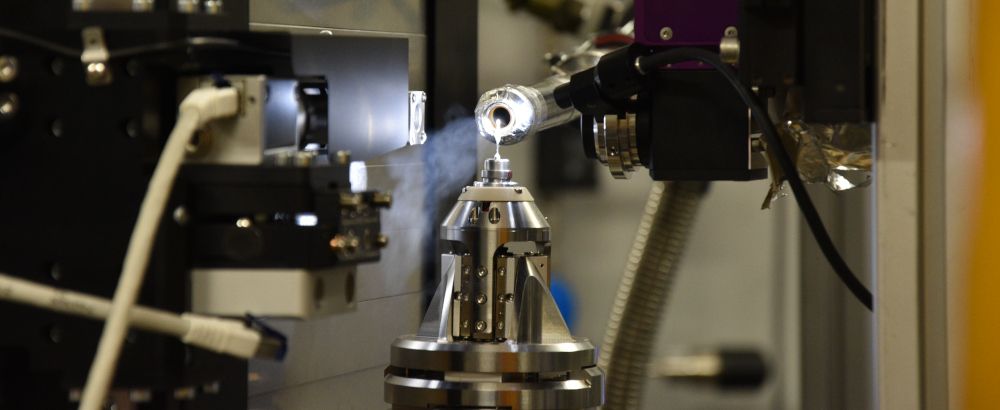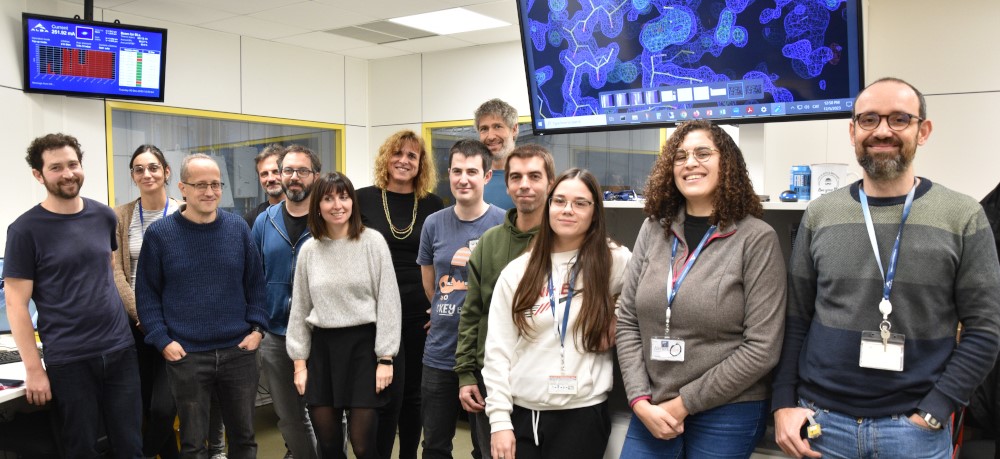Do you want to keep up to date? Subscribe to our newsletter. 1 mail every 2 months! |
 |
(Part of) the team involved in XAIRA installation, gathered in the beamline Control hutch to celebrate the achievement of this milestone.
Cerdanyola del Vallès, 22nd December 2023 At XAIRA beamline, the largest efforts for the last two months have been devoted to the installation of the beamline End Station, which includes all the instrumentation required for positioning of the sample and the actual recording of diffraction data. Previously, the beamline optics had also been commissioned, to filter the X-rays in the synchrotron light produced by the insertion device (the XAIRA source) and focus them onto the sample position.
Thanks to all this previous work, on December 1st the focused X-ray beam was used to illuminate a crystal of hen egg-white lysozyme, leading to the first protein diffraction of the beamline. To collect oscillation data, the sample, which is held on a diffractometer, was rotated during data collection. The XAIRA diffractometer is a set of high-precision stages combined with an air/helium-bearing goniometer, has been designed and built in-house, with the purpose of maintaining the sample within the beam path with a high level of precision, even when turning at speeds of 1 turn per second or even higher.

Diffraction data was collected with XAIRA's state-of-the-art detector, an Eiger2 XE 9M hybrid pixel-array detector, at 100 Hz (that is, 100 frames per second, which means 1 frame every 0.01 seconds). The whole experiment lasted just 36 seconds, during which 3600 images (~8 GB of data) were collected. Data was then processed using the beamline fast data processing pipeline.
The first diffraction experiment. a) Image of the lysozyme crystal, as seen with the sample visualisation system. A red cross indicates the position where the sample overlaps with the beam path. b) Detail of one of the 3600 frames collected in this single experiment. Diffraction spots show nicely against the very low background. c) Snapshot of the electron density map (2σ 2Fo-Fc in blue, F0-Fc in green/red) obtained from the experiment data by molecular replacement, showing a nice fitting of the polyalanine protein model (PDB id 5L9J) and the high level of detail of the Tryptophan and Tyrosine side chains (green densities, not modelled).
In further tests performed the following days, ultrafast data collection was also achieved. In these tests, full (360º oscillation) data sets were collected in times as short as 1 second, as well as performing other collections at 500 Hz and 1000 Hz (1 frame every 0.002 or 0.001 seconds). For these experiments to be successful, a high photon flux is required; at XAIRA, this can be achieved thanks to the multilayer crystals of XAIRA monochromator (also a novel in-house design), capable of producing beam fluxes > 1013 ph/s.
XAIRA team is now working on the installation of the first part of the Helium chamber that will enclose the whole End Station, allowing to maintain a Helium atmosphere around the sample, and up to the detector. Such environment will greatly reduce the background noise recorded at the detector while maintaining the sample diffraction signal, thus resulting in even better data.
Following this very successful first diffraction achievement, the next milestone will be to finalise installations at the Experimental Hutch and starting to measure friendly user samples.

This project is co-funded by the European Regional Development Fund (ERDF) within the Spanish Pluri-Regional Operative Programme (former Smart Growth Operative Programme) 2014-2020.






